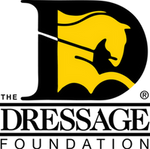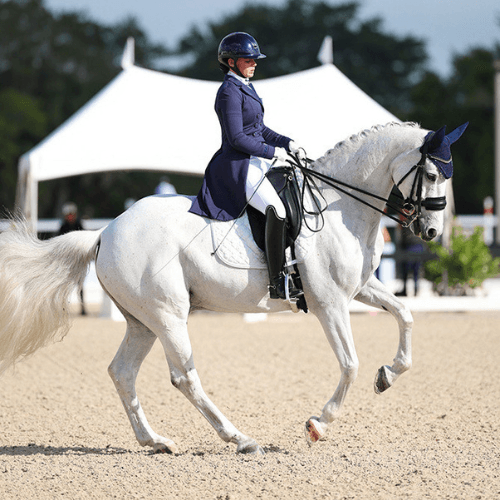
Tessa Holloran credit Astrid Appels
Day One at the CHIO Aachen:
Today we had the pleasure of meeting with Olympian Allison Brock; Dr. Johan Lenz of the Swedish Team; Markus Scharmann, Head of the German National Training Center; and Astrid Appels of Eurodressage. We asked each of them for their thoughts on the current state of the sport and where they see it heading in the future. Their insights were incredibly valuable!
We had the opportunity to watch the schooling in the big ring, and it gave me a completely new perspective on the competition. What stood out most was seeing all the top riders training together in the same arena. Usually, we only see them individually during their tests or while warming up, so watching them side by side made it much easier to notice the differences in riding style, technique, and each horse’s way of going.
It was especially interesting to see how one pair might stand out on their own, but when placed next to another top rider, their ride didn’t look quite as impressive, even though it was still very, very good. That comparison really put things into perspective for me. It showed just how high the standard is at this level and how subtle elements like harmony and precision can make all the difference.
I also realized how many different approaches exist among these top riders—some focused on specific movements, while others worked on simple transitions. It was an incredibly valuable learning experience.
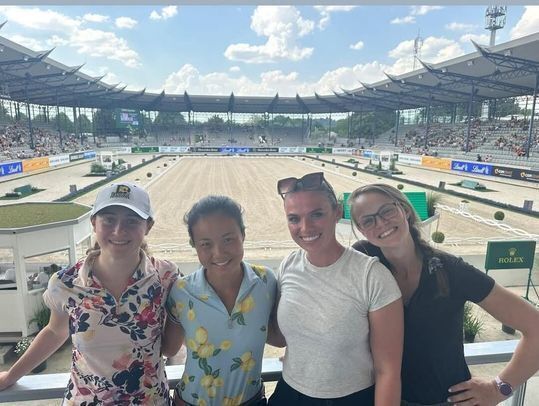
Competition at the main dressage arena in Aachen
Day Two:
Over the past two days, we’ve had the opportunity to interview some very influential people in the sport and asked each of them the same question: “Where do you think this sport is going, and how would you change it?”
One of the comments that’s stayed with me the most came from Dr. Lenz of the Swedish team. He said, “An issue is that some don’t understand what an aid actually is, so learning what an aid truly is—and the difference between an aid and when it turns into violence—is very important.”
The topic of horse welfare has rightfully gained more attention in recent years, and Dr. Lenz’s words reminded me of a panel discussion I attended this past season in Wellington, hosted by Dressage4Kids. The panel was titled “From an Instructor's Perspective: The Current State of Affairs, Ethics, and Social License.” During the discussion, someone posed the question: Is it better to apply constant, ineffective aids that create unrelenting pressure for the horse, or to give one stronger, clearer aid that actually leads to a response?
Thinking back to that conversation, and connecting it to Dr. Lenz’s point about truly understanding the purpose of an aid, raised some important questions in my mind. I found this perspective incredibly thought-provoking, and I believe it’s something that everyone in the sport should reflect on.
Watching the top dressage riders in the world is incredibly inspiring—not just because of their talent, but because they’re human too. Even at the highest level, with the best of the best, mistakes still happen. Maybe there’s a missed change in the tempis, a misstep in the pirouette, or a transition that comes a moment too soon.
What stood out to me was how these riders didn’t let those mistakes define the rest of the ride. It was a powerful reminder that perfection is not the standard—resilience is. Recovering and making up points elsewhere is part of the sport. Mistakes don’t mean failure; they are part of the journey, even at the top. In fact, they’re what help us become better riders—teaching us to persevere and stay focused without letting a single moment derail the entire ride.
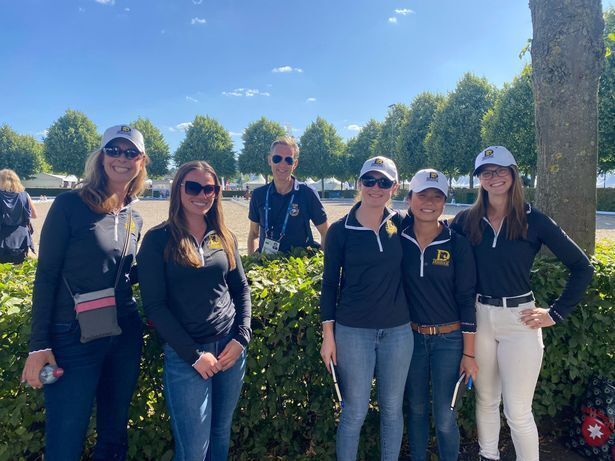
With Swedish Team Vet, Dr. Johan Lenz
Day Three:
Today, we had the opportunity to meet with FEI judge Janet Foy, Swedish team member Tinne Vilhelmson-Silfvén, German rider and trainer Michael Klimke, British team rider Becky Moody, and Dream Program sponsor Margaret Duprey.
A common theme across all conversations was that no matter how experienced you are, there’s always more to learn, refine, and improve. It’s not just about individual growth—it’s about being open to learning from others. By sharing knowledge, experiences, and insights, we create a collaborative environment that helps move the sport forward.
Through this collective effort, we can continue heading in the right direction and elevate dressage together. Especially now, it’s important to promote the positive aspects of our sport and remind the world just how amazing dressage truly is.
The international aspect of the event significantly influenced my perspective, especially in how dressage is perceived and appreciated outside the United States. It quickly became clear that the horse culture here is much deeper and more ingrained. Horses and equestrian sports are part of the broader culture, and the general public genuinely understands both the technical and artistic aspects of dressage.
One of the most striking differences was how in tune the audience was with each ride. If a rider made a noticeable mistake during a test, you could hear a collective gasp from the crowd—showing their knowledge and engagement.
It was also surprising and inspiring to see young children attending on school field trips, learning about the sport, and developing an appreciation for it from an early age. That kind of exposure is rare back home. This experience gave me a glimpse into what it looks like when a sport is embraced on a cultural level. It deepened my respect for the international dressage community and its powerful influence on future generations.
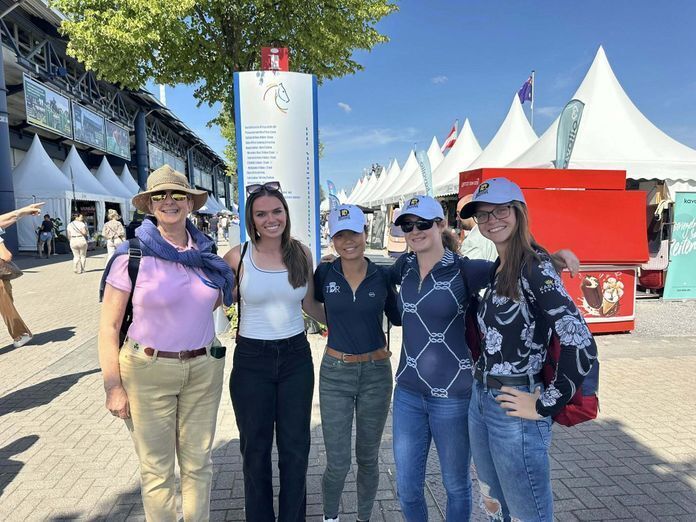
With Dream Program Donor, Margaret Duprey
Day Four:
Today’s experience at Aachen has truly reignited my drive and deepened my dressage goals. Watching the crowd and the electric atmosphere made me realize just how much I want to compete in that ring one day. The energy, support, and excitement from the audience created a powerful environment that I would be honored to be part of. Being able to experience all these people sharing the same passion and dedication was incredibly inspiring. The idea of representing the U.S. in that arena would be an absolute dream. It reminded me that with continued focus, hard work, and patience, that dream is possible.
Overall, this week has truly shifted my perspective on what’s possible in my own dressage journey. Speaking with multiple top riders, I was encouraged by how many believe the sport is moving in a positive direction. They emphasized the importance of blocking out negativity and focusing on the progress being made, something that really stuck with me. It’s easy to get caught up in pressure or comparison, but this reminded me to stay grounded in my own path.
What inspired me most was hearing riders talk about bringing up their horses from a young age and now competing here at Aachen. It reminded me that greatness in this sport isn’t instant, it’s built over years of partnership, patience, and consistency. These riders have been doing this for so long, gaining knowledge and experience that’s shaped who they are in the saddle today.
I’ve come away from this experience feeling more motivated than ever, but also more at peace with where I am. There’s no rush. I have many, many years ahead to grow, learn, and evolve. Seeing how long it truly takes to reach the top has made me more confident that I’m exactly where I need to be right now.
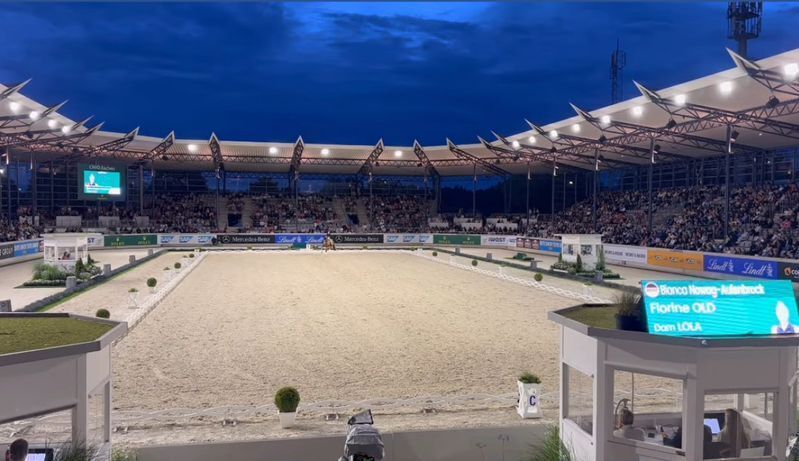
Dressage under the Aachen lights
Day Five:
This trip was truly such an incredible experience, and I am so honored to have been selected as a participant!
One of the most impactful lessons I’m taking home from this trip is that you need to keep riding in the ring even in such an exciting and loud type of environment. I find sometimes at shows I’m so worried about making a mistake that I forget that I still need to implement my training. This sport isn’t about perfection. It’s about resilience, determination, and staying mentally present. Watching elite riders handle tough moments with composure reminded me to never stop riding, never give up, and never lose sight of why we do this. At the end of the day, we do this because of the love we have for horses. That connection is what truly matters, and it should always guide our goals and our journey.
The most surprising and insightful thing we heard during our conversations with riders was how many of them emphasized the importance of focusing on what you can control when facing setbacks. We asked nearly every rider we spoke with how they deal with challenges or disappointments, and while each shared a personal strategy, the common thread across all their answers was to not dwell on the negatives. Instead, they encouraged us to take what we can learn from each situation, let go of what we can’t change, and move forward.
This mindset was especially powerful coming from top riders who compete in the biggest shows. Many of whom have been through injuries, bad rides, or years of developing a horse that didn’t make it to the top. Yet they’ve remained grounded and resilient, which made me realize that setbacks are not a sign to stop, but an opportunity to grow.
It also made me reflect on how easy it is to get stuck in your head after something goes wrong, when in reality, progress comes from continuing on. Their advice reminded me that it’s not about being perfect, it’s about learning how to deal with these challenges and being able to overcome them and keep striving for the next thing.
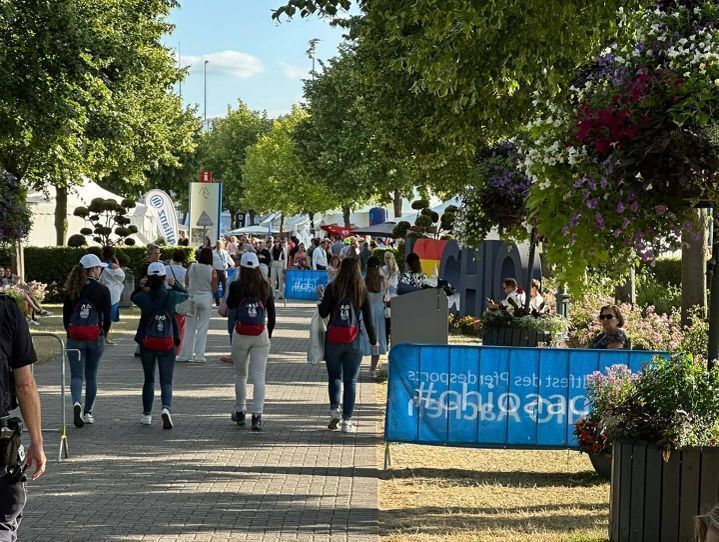
Experiencing all that CHIO Aachen had to offer
